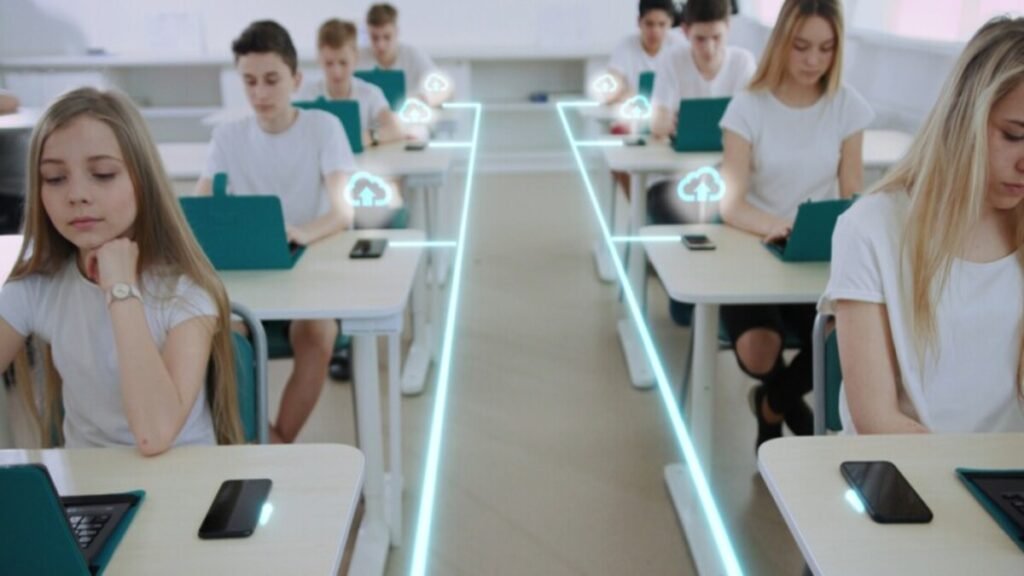Tech in education is more than a trend—it’s a revolution. Across the United States, classrooms are going digital. From elementary schools to high schools and beyond, students are using laptops, tablets, and apps to learn in exciting new ways.
Teachers are also changing how they teach. Traditional blackboards are being replaced by smartboards, and lessons once found in textbooks are now interactive videos and online modules. The result? More personalized, engaging, and flexible learning experiences for every student.
In this article, we’ll explore how tech in education is transforming American classrooms, what tools are being used, and what the future of learning looks like.
Why Tech in Education Matters More Than Ever
The COVID-19 pandemic pushed digital learning into the spotlight, but its impact goes far beyond remote schooling. Tech in education helps close learning gaps, increases access to resources, and prepares students for a tech-driven future.
🎓 Benefits of Educational Technology:
- Equal Access: Students in rural or underserved areas can access high-quality learning.
- Personalized Learning: Platforms adjust lessons based on each student’s pace.
- Engagement: Gamified learning and multimedia keep students interested.
- Real-World Skills: Students learn to use tech tools they’ll need in future jobs.
Whether in person or online, tech helps make learning more inclusive, adaptive, and fun.
Digital Tools Making a Difference in U.S. Classrooms

Let’s break down the major technologies shaping K–12 education across America:
💻 1. Chromebooks and iPads
Devices like Google Chromebooks and Apple iPads are now standard in many schools. These portable tools allow students to write essays, join virtual classes, or complete assignments from anywhere.
🌐 2. Learning Management Systems (LMS)
Platforms like Google Classroom, Canvas, and Schoology help teachers manage lessons, grades, and communication all in one place.
📱 3. Educational Apps and Software
Apps like Khan Academy, Duolingo, Quizlet, and Seesaw make learning interactive. Students can practice math problems, learn a new language, or create digital portfolios.
🧠 4. Artificial Intelligence (AI)
AI-powered tools provide real-time feedback, adaptive quizzes, and even tutoring support. Some apps analyze student performance and suggest what to learn next.
🕶️ 5. Virtual and Augmented Reality (VR/AR)
Imagine learning about the solar system by “flying” through it in VR. These immersive tools help make abstract or complex topics easier to understand.
How Teachers Are Using Tech to Improve Learning
Teachers are at the heart of tech in education. While technology offers powerful tools, it’s how teachers use them that makes the difference.
👩🏫 Teaching Strategies with Technology:
- Flipped Classrooms: Students watch lectures at home and do activities in class.
- Project-Based Learning: Tech tools help students collaborate on real-world projects.
- Blended Learning: Combines online learning with face-to-face teaching.
- Data-Driven Instruction: Teachers use digital assessments to tailor lessons.
With the right support, teachers can use tech to make learning more engaging and effective for every student.
Digital Equity: Bridging the Tech Gap
While many schools are thriving with tech, not every student has equal access. The digital divide remains a major challenge in the U.S.
🚫 Common Barriers:
- Lack of internet at home.
- Limited access to personal devices.
- Inadequate tech training for teachers.
To solve this, many school districts are:
- Partnering with internet providers to offer free or low-cost Wi-Fi.
- Providing loaner laptops and tablets to students.
- Offering digital literacy training for students and educators.
Improving tech equity ensures every student has a chance to succeed, no matter their background.
Real-World Examples of Tech in American Classrooms
📚 Baltimore County Public Schools
This Maryland district launched a 1:1 device program, giving every student a laptop and access to online textbooks and assignments.
🧬 San Diego Unified School District
Using digital science labs, students can run virtual experiments they might not be able to do in person due to safety or cost.
🖥️ New York City Schools
NYC schools have invested heavily in remote learning platforms, ensuring over 1 million students can access digital lessons from home.
👨🔬 Rural Schools in Kansas
Small towns in Kansas are using video conferencing to offer advanced STEM courses taught by teachers in other districts.
These examples show how tech in education is helping students learn anytime, anywhere.
Challenges Facing Digital Learning in U.S. Schools
Even with all the benefits, integrating tech into classrooms isn’t always easy.
⚠️ Common Challenges:
- Screen Time: Concerns about too much time on devices.
- Cybersecurity: Protecting student data is more important than ever.
- Tech Fatigue: Both teachers and students can feel overwhelmed.
- Training Gaps: Not all teachers are fully trained on how to use new tools.
To overcome these hurdles, schools need proper funding, support staff, and ongoing professional development for educators.
The Role of Government and Policy in Educational Technology
Federal and state governments play a big role in expanding tech in education.
🏛️ Key Programs and Investments:
- E-Rate Program: Helps schools get affordable internet access.
- ESSER Funds: Provided billions in emergency relief during the pandemic, much of which supported digital learning.
- Future Ready Schools Initiative: Encourages school districts to develop tech-based learning plans.
These efforts are helping schools build long-term digital learning strategies, not just temporary fixes.
Preparing Students for a Digital Future
Today’s students are tomorrow’s workforce. By using tech in classrooms, schools are helping students build essential digital skills.
🔧 Important Skills Students Are Learning:
- Typing and digital communication
- Using productivity tools like Google Docs and Excel
- Coding and basic programming
- Research and online safety
In many ways, classrooms are becoming the first training ground for jobs in tech, healthcare, finance, and beyond.
The Future of Tech in Education
The future of tech in education is full of possibility. As technology continues to evolve, we’ll likely see:
🚀 Future Trends:
- AI Tutors: Personalized help for every student, 24/7.
- Gamified Classrooms: Lessons turned into video-game-like experiences.
- Blockchain Transcripts: Secure and easy transfer of academic records.
- Global Classrooms: Students collaborating with peers worldwide.
While the tools may change, the goal remains the same: helping students succeed through better, smarter, and more connected learning.
Final Thoughts
Tech in education is not about replacing teachers—it’s about empowering them. When used the right way, digital tools can make learning more engaging, accessible, and effective for every student.
From rural districts to urban centers, U.S. classrooms are embracing this shift with creativity and commitment. As schools continue to innovate, tech will play a key role in shaping the future of American education
For More – From Textbooks to Holograms: AR is Changing US Education






